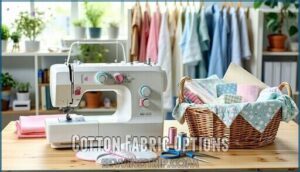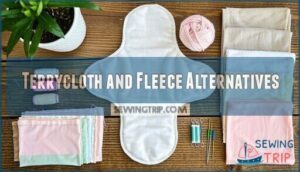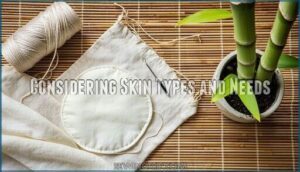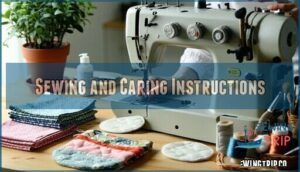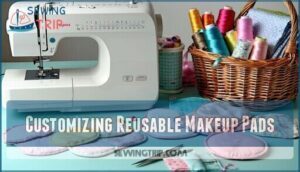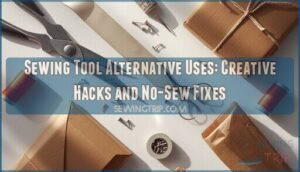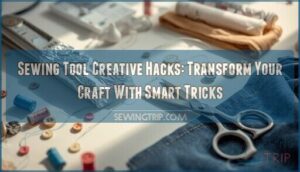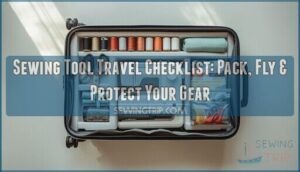This site is supported by our readers. We may earn a commission, at no cost to you, if you purchase through links.
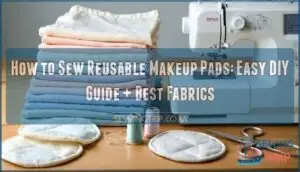 Learning how to sew reusable makeup pads is surprisingly simple and rewarding.
Learning how to sew reusable makeup pads is surprisingly simple and rewarding.
You’ll need soft fabric like cotton flannel or bamboo, thread, scissors, and about 30 minutes.
Cut two fabric circles per pad, place them right sides together, sew around the edge leaving a small opening, then turn inside out and topstitch closed.
These eco-friendly alternatives save money while being gentler on your skin than disposable options.
The best part is that you can customize the size and softness for your specific needs.
Once you master the basic technique, there are clever tricks to make your pads even more effective and long-lasting.
Table Of Contents
Key Takeaways
- You’ll need basic materials like cotton flannel or bamboo fabric, thread, and scissors to create soft, effective makeup pads in about 30 minutes.
- Cut two fabric circles per pad, sew them right sides together leaving a small opening, turn inside out, and topstitch closed for durable construction.
- These eco-friendly alternatives save money long-term while being gentler on your skin than disposable cotton rounds, and you can customize size and softness.
- Proper care involves washing in mesh bags with mild detergent (skip fabric softener), air drying, and storing in breathable containers to ensure years of use.
Sewing Reusable Makeup Pads
You’ll love how making your own reusable makeup pads helps the planet while saving you money on those endless boxes of cotton rounds.
Transform your beauty routine into an eco-friendly ritual that saves money and reduces waste with every gentle swipe.
These simple fabric circles are surprisingly easy to sew and work better than store-bought disposables for removing even stubborn mascara, which is a great advantage of using reusable makeup pads.
Benefits of Reusable Pads
Sustainability transforms your beauty routine through reusable makeup pads.
You’ll slash waste reduction by eliminating thousands of disposable cotton rounds annually.
These eco-friendly alternatives deliver impressive cost savings – one set replaces years of purchases.
Your skin health improves with gentler, customizable fabrics.
This zero waste makeup approach supports sustainable skincare while creating the perfect cotton rounds alternative for DIY skincare enthusiasts.
Materials Needed for Sewing
Gather your supplies before starting this rewarding project! You’ll need basic tools that most sewers already have on hand.
Here’s your essential shopping list for creating reusable makeup pads:
- Fabric Types: Cotton, flannel, or microfiber for the soft side
- Cutting Tools: Sharp fabric scissors or rotary cutter for clean edges
- Thread Selection: All-purpose polyester thread matching your fabric colors
Consider using similar materials to those used in reusable menstrual products for maximum absorbency.
Don’t forget marking tools for tracing circles and pin alternatives like clips if you prefer them over traditional pins!
Choosing The Right Fabric
Your fabric choices make or break your reusable makeup pads.
The right fabric is the foundation of pads that actually work instead of falling apart after one wash.
Cotton offers gentle cleansing with good absorbency levels, while flannel provides extra softness for skin sensitivity.
Consider fiber content and weave density – tighter weaves last longer but looser ones feel softer.
Match fabric softness to your skin type for comfortable daily use, ensuring a comfortable experience.
How to Make Reusable Pads
Ready to turn those fabric scraps into eco-friendly magic? Making reusable makeup pads is surprisingly simple and you’ll wonder why you waited so long to ditch those wasteful cotton rounds.
Start by creating your template using any round object like a mason jar lid or glass. Trace circles onto your chosen fabrics, then cut them out with sharp scissors or a rotary cutter.
Here’s your basic roadmap:
- Pair two fabric circles with right sides facing out
- Pin the layers together to prevent shifting while sewing
- Stitch around the edges using a zigzag or overcast stitch
- Trim any excess threads for a clean finish
The beauty of DIY makeup remover pads lies in their simplicity. You don’t need perfect circles or fancy stitch types – these washable pads work great even with slightly wonky edges. Focus on pad durability by double-stitching if your fabric tends to fray.
Once you’ve mastered the basic technique, you can experiment with pattern customization and different remover recipes. You can also find inspiration from resources detailing reusable pad materials.
Selecting Fabric Materials
Choosing the right fabric makes all the difference between pads that pamper your skin and ones that feel like sandpaper.
You’ll want soft, absorbent materials on one side for gentle makeup removal and durable fabric on the back that won’t fall apart after a few washes.
Cotton Fabric Options
You’ll find cotton weaves offer the perfect balance of absorbency and durability for reusable makeup pads.
Organic cotton delivers exceptional gentleness without synthetic chemicals, while printed cottons add personality to your collection.
Cotton blends combine softness with strength, and higher thread count fabrics provide smoother texture against skin.
Consider using certified organic options for added peace of mind, and choose absorbent cotton fabric that matches your skincare routine with certified organic options.
Terrycloth and Fleece Alternatives
Beyond traditional cotton, terrycloth fabric offers superior absorbency for removing stubborn makeup, while fleece alternatives provide gentler treatment for sensitive skin.
Upcycled towels work perfectly for terrycloth options, and knit scraps can create soft fleece alternatives.
Bamboo fabric and hemp options deliver eco-friendly choices, though organic cotton remains most accessible.
These fabric scraps transform into effective reusable cotton pads, considering the importance of natural fiber benefits for durability and sustainability, as seen in the link to natural fiber benefits, which highlights the value of using sustainable materials.
Considering Skin Types and Needs
Your skin type matters when choosing reusable makeup pads.
Sensitive skin needs natural fibers like organic cotton to prevent allergic reactions. If you have skin conditions like rosacea, skip synthetic materials that cause irritation.
Bamboo fabric works great for gentle care since it’s naturally antimicrobial.
These handmade facial rounds become your go-to ecofriendly beauty solution when matched to your skin’s needs.
Sewing and Caring Instructions
Now that you’ve gathered your materials and cut your fabric pieces, it’s time to bring your eco-friendly makeup pads to life through simple sewing techniques.
You’ll discover that proper construction and care will keep these sustainable beauties working perfectly for years to come.
Step-by-step Sewing Guide
Throughout the journey of creating DIY facial pads, you’ll discover that mastering sewing basics transforms simple fabric scraps into washable makeup remover essentials.
This step-by-step process combines smart fabric selection with essential sewing tools for professional results. Utilizing effective sewing fabric scraps techniques can substantially improve the overall quality of your DIY projects.
- Trace circles on your chosen fabric using a round template like a mason jar lid
- Pin two fabric circles together with right sides facing out for easy assembly
- Sew around edges using a serger, zigzag stitch, or overcast stitch for durability
- Create multiple fabric makeup pads in one session to build your complete collection
Washing and Maintaining Reusable Pads
After each makeup session, toss your reusable face wipes into a mesh laundry bag for pad sanitation.
Machine wash these washable makeup remover pads on gentle cycle with mild detergent for effective stain removal. Skip fabric softeners—they’ll reduce absorbency!
Air dry to maintain shape.
These maintenance hacks keep your reusable products fresh and functional for months.
Tips for Durability and Longevity
Your handmade facial rounds will last years with smart fabric choices and proper sewing techniques.
Double-stitch edges using zigzag or serger methods for bulletproof durability.
Choose quality materials like bamboo terry or organic cotton—they’ll outlast cheap alternatives every time.
Store your reusable face wipes in breathable containers between uses.
Follow these laundry tips: wash with towels, skip fabric softener, and air dry when possible for zero waste makeup removal success.
To maintain the quality of your reusable makeup pads, understanding fabric care tips is essential for their longevity and to ensure proper care.
Customizing Reusable Makeup Pads
Once you’ve mastered the basic technique, you can personalize your reusable makeup pads to match your style and needs perfectly.
From experimenting with different shapes and sizes to creating beautiful storage solutions, customization makes this eco-friendly project uniquely yours, allowing for personalize to be expressed through various creative avenues.
Variations in Shape and Size
Beyond basic circular pads, you’ll discover endless shape possibilities that match your specific beauty routine perfectly.
Different shapes serve unique purposes – from precise eye makeup removal to full-face cleansing coverage.
- Circle Pads – Classic 3-4 inch rounds work great for most makeup removal tasks
- Oval Shapes – Perfect for eye area contouring and gentle under-eye cleansing
- Rectangular Wipes – Ideal for covering larger face areas with fewer pads needed
- Mini Rounds – Tiny 2-inch circles excel at detailed work like lip cleanup
- Custom Sizes – Create jumbo washable wipes or pocket-sized fabric circles for travel
Adding Embellishments or Decorations
Pretty pads deserve pretty touches! Add personality with fabric paint designs, delicate lace trim around edges, or small ribbon embell details.
Try simple applique art using contrasting fabrics, or attach tiny bead decor for sparkle. These sewing embellishments transform basic handmade beauty products into special reusable beauty products.
Your ecofriendly beauty routine becomes uniquely yours with these creative DIY beauty wipes touches. Exploring various fabric paint designs can help inspire unique and personalized reusable makeup pads, making your ecofriendly beauty routine more uniquely yours with creative DIY beauty wipes touches.
Creating Sets and Storage Solutions
Smart storage sets transform scattered pads into organized beauty essentials.
Create matching sets of 10-15 reusable makeup pads, then craft coordinated storage solutions.
Try breathable cotton organizer boxes with labels, or sew travel pouches with snap closures.
Add mesh cosmetic bags for washing cycles.
Mason jars work perfectly as stylish makeup cases for countertop display, keeping your DIY beauty products visible and accessible, and can be part of a storage solution.
Frequently Asked Questions (FAQs)
What are reusable makeup pads made of?
Reusable makeup pads combine two fabric types: a soft, gentle side like microfiber or fleece touches your skin, while the back uses cotton, jersey knit, or terrycloth for durability and structure.
They are designed to provide both comfort and durability.
Are reusable face pads worth it?
You’ll save money long-term since they replace hundreds of disposable cotton rounds.
They’re gentler on your skin, work better with makeup removers, and you can toss them in the washing machine.
It’s a win-win for your wallet and the planet.
How many makeup pads should I make?
Like a baker deciding how many cookies to make for a week, you’ll want enough makeup pads to last between washes.
Make 10-15 pads – that gives you a solid rotation while some are in the laundry.
Can I use fabric softener when washing?
Skip fabric softener when washing your makeup pads.
It leaves residue that reduces absorbency and can irritate sensitive skin.
You’ll want these pads to work effectively, so stick with regular detergent only, to ensure they maintain their absorbency.
How long do homemade pads typically last?
Your homemade makeup pads will typically last 1-2 years with regular use and proper care.
They’ll stay soft and effective through hundreds of washes if you avoid fabric softener and air dry them.
Whats the best makeup remover for pads?
Studies show Americans throw away 20 billion cotton rounds annually. You’ll love mixing water with jojoba oil – it’s gentle, non-comedogenic, and removes makeup effectively without harsh chemicals or irritation.
Can I make different sizes together?
You can mix different sizes in one batch. Just use various templates like glasses, lids, or bowls to create small, medium, and large pads for different makeup removal needs.
Conclusion
Transforming fabric scraps into skincare gold has never been easier!
Now that you’ve learned how to sew reusable makeup pads, you’re ready to create your perfect collection.
Start with simple cotton circles, then experiment with different textures and sizes.
Your wallet and skin will thank you for ditching those harsh disposables.
With proper care, these handmade pads will serve you for years, making every makeup removal session feel luxurious and eco-friendly.
- https://courses.sewcanshe.com/courses/all-sewcanshe-printable-tutorials
- https://docs.google.com/forms/d/1GAQr3Kn1cURCVHUA82hAga1Wv8DCH0IuqDLRUrOpN7M/viewform?ts=63f4f653&entry.1515682415=https://www.merriam-webster.com/dictionary%2Fsew
- https://premium.britannica.com/mw-unabridged/?utm_source=mw&utm_medium=inline-def&utm_campaign=evergreen

